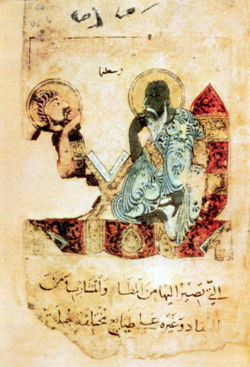Jabril ibn Bukhtishu

Jabril ibn Bukhtishu, (Jibril ibn Bakhtisha) also written as Bakhtyshu, was an 8th-9th century physician from the
Grandson of Jirjis ibn Jibril, he lived in the second half of the eighth century.
He was physician to
He wrote various medical works and exerted much influence upon the progress of science in Baghdad. Works attributed to him include Kitāb ṭabā’i‘ al-ḥayawān wa-khawāṣṣihā wa-manāfi‘ a‘ḍā’ihā ('Book of the Characteristics of Animals and Their Properties and the Usefulness of Their Organs'), written for Nasir al-Dawla; Risāla fī al-ṭibb wa-al-aḥdāth al-nafsāniyya ('Treatise on Medicine and Psychological Phenomena'); and Kitāb naʿt al-hayawān.[1] He was a member of the Bakhtyashu family. He took pains to obtain Greek medical manuscripts and patronized the translators.
See also
- List of Persian scientists
- The Bukhtishu family.
- Bukhtishu, Abdollah ibn.
- Yuhanna ibn Bukhtishu
Further reading
- F. Wüstenfeld, Arabische Aerzte (15-16, 1840).
- Lucien Leclerc, Médecine arabe (vol. 1, 99-102, 1876).
- Max Meyerhof, New Light on Hunain ibn Ishaq (Isis, VIII, 717, 1926).
References
- ^ JSTOR 1523325.
- ^ "Islamic Culture and the Medical Arts: Greek Influences". U.S. National Library of Medicine.
Further reading
- Weststeijn, Johan (2008). "Van het Reve on 'Literaturwissenschaft'". In Haard, Eric Alexander; Stelleman, Jenny (eds.). Literature and Beyond: Festschrift for Willem G. Weststeijn on the Occasion of His 65th Birthday. Pegasus. pp. 867–884. ISBN 978-90-6143-326-2.
